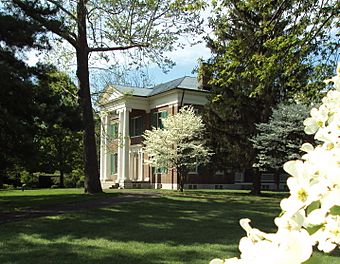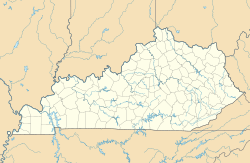Waveland State Historic Site facts for kids
Quick facts for kids |
|
|
Waveland
|
|
 |
|
| Nearest city | Lexington, Kentucky |
|---|---|
| Built | 1845 |
| Architectural style | Greek Revival |
| NRHP reference No. | 71000342 |
| Added to NRHP | August 12, 1971 |
Waveland State Historic Site, also known as the Joseph Bryan House, is a special place in Lexington, Kentucky. It features a beautiful home built in the Greek Revival style. Today, 10 acres of the property are a state park.
This was once the home of the Joseph Bryan family. Many people, including enslaved individuals, lived and worked here in the 1800s. Joseph Bryan's great-grandfather, William Bryan, was a friend of the famous explorer Daniel Boone. They traveled west together through the Cumberland Gap.
Joseph Bryan became an early farmer in this area. He started a large farm, growing crops like tobacco and hemp. He also began to raise fast thoroughbred race horses.
Contents
The Story of Waveland
The families of Daniel Boone and William Bryan first met in North Carolina. William Bryan married Mary Boone, who was Daniel Boone's sister. They had a son named Daniel Boone Bryan. Daniel Boone helped his nephew by surveying, or mapping, a large piece of land in Kentucky. This land was about 2,000 acres, located six miles from what is now downtown Lexington, Kentucky.
Daniel Boone Bryan's Home
Daniel Boone Bryan settled on this land around 1786. The property later got its name, Waveland, because the fields of grain and hemp looked like waves when the wind blew. The area, known as the Bluegrass Region of Central Kentucky, was famous for producing hemp and rope in the 1800s. When Daniel Boone Bryan first moved here, he built a small stone cabin.
Joseph Bryan Builds a Mansion
Joseph Bryan, Daniel Boone Bryan's son, inherited Waveland. He built the main house, often called the "Big House," between 1844 and 1848. Joseph and his wife, Elizabeth, had twelve children. Bryan chose to build his home in the classic Greek Revival style. This style was inspired by ancient Greek buildings.
He hired Washington Allen, a well-known builder from Lexington. The house featured a grand portico (a porch with columns) and a large entry hall. The main front door looks just like the north entrance of the Erechtheion temple in Athens, Greece. There were also porches on both sides of the house. These porches offered lovely views of the countryside. The first-floor rooms were very tall, about fourteen feet high. This design helped keep the house cooler in the summer.
A Self-Sufficient Farm
Like many large farm owners, Joseph Bryan made his farm almost like a small town. It had many different businesses. For example, a gunsmith shop once employed twenty-five men. They made saltpeter and gunpowder. The farm also had a gristmill (for grinding grain) and a paper mill. This mill also processed lumber. There was a blacksmith shop and even a distillery, which made bourbon. Kentucky was famous for its bourbon. Bryan managed all these businesses very well.
Bryan also set aside space on his farm for a Baptist church. He also had a private school for girls. At that time, Kentucky did not have public schools.
Many materials for the house came right from the farm. The lumber was cut and shaped at Waveland. The metalwork was made at his blacksmith shop. Bricks for the buildings were made from clay found on the land. Stones for the foundation came from a quarry near the Kentucky River. To save money, Bryan used flat pieces of wood for the stairway rail instead of rounded ones. His wife wanted expensive marble baseboards. Instead, Bryan used cheaper stones and painted them to look like marble.
Joseph Bryan's office was very unique. It had seven doors, each for a different purpose. One door led to the formal dining room. Another door opened into the family parlor, where he could spend time with his children.
A special door, which locked from his office, led to stairs. These stairs went up to two rooms on the second floor. Bryan rented these rooms to travelers. He could lock this door to keep his family safe at night. Travelers could not leave their rooms until Bryan unlocked the door. This protected his family from being robbed or attacked.
Another door led outside to the back of the house. This gave him quick access to the farm buildings and fields. This made it easier to communicate with the enslaved African Americans who worked there. Another door led to the road. Businessmen often visited Bryan, and this door allowed them to come directly to his office. The last two doors were closets. He used these as safes to store important items.
Life for Enslaved People
Before the Civil War, the Bryans owned enslaved people. They had thirteen enslaved individuals: three women and ten men. The women did all the household chores. This included cleaning, washing, ironing, cooking, and preparing food. Joseph's wife, Margaret Cartmell Bryan, made clothes for her family and for the enslaved people. The invention of the sewing machine later made this work much faster.
The enslaved men worked on the farm. Each man was responsible for about 20 acres of land. To save travel time, the Bryans allowed the enslaved people to build their homes on the land they worked. The enslaved people at Waveland had some freedoms that were not common for others at that time. When they were not working, they could hunt for food. They could also buy and sell goods at local markets and keep any money they earned. Joseph Bryan even allowed them to have weapons. Their homes were built with two layers of bricks. This made them better insulated than many other homes in Kentucky.
During the Civil War, Joseph Bryan supported the Confederacy. He provided them with supplies like horses and food from his farm. When the Union army found out, they tried to arrest him. Bryan escaped to Canada. He returned years later after the war ended. The enslaved people at Waveland became free when the war ended. Most of them chose to stay and work for Bryan, but now they were paid for their labor and paid rent for their homes.
Joseph Henry Bryan's Legacy
Joseph Henry Bryan, one of Joseph Bryan's children, lost his own house. So, he, his wife, and their children moved back to Waveland with his father. Eventually, Joseph Bryan Sr. moved out, and Joseph Henry Bryan became the owner of Waveland.
Joseph Henry Bryan became famous for raising racehorses. Waveland became one of Kentucky's top farms for thoroughbred and standardbred (trotting horses). Some famous horses from Waveland included "Waveland Chief," "Ben-Hur," "Eric," "Olaf," and "Wild Rake." "Wild Rake" was an amazing horse that never lost a race. He was sold to William Rockefeller for $7,800 in the 1880s. Joseph Henry Bryan also built a race track across from the mansion. He and other businessmen would watch the races from near the track. It was not considered proper for women of their social class to be at the track. So, Bryan's wife, daughters, and female guests would often go to the top floor of the house. They would watch the races with binoculars from there.
Joseph Henry Bryan loved to gamble. In less than seven years, he lost over one million dollars. Another family member had to sell their home to try and help him keep Waveland. However, Bryan could not pay his debts. His family never forgave him for this. He had to sell the house at an auction to try and pay off what he owed.
Salle A. Scott bought Waveland in 1894. She sold it in 1899 to James A. Hullet. In 1956, the state of Kentucky bought the house and about 200 acres of the original land. The house was bought for preservation. The larger farmland was given to the University of Kentucky for research and farming experiments.
Waveland as a Museum
In 1957, Waveland became a historic house museum. It shows what life was like in Kentucky from the early pioneer days up to the Civil War. The museum includes the house and 10 acres of land. The house has been restored and furnished to look like a plantation home in the 1840s. Many old pieces of furniture were given to the museum. Sadly, many of the smaller buildings on the farm did not survive over the years.
Today, Waveland has the main mansion, decorated in the style of the 1840s. It also has four other buildings: the ice house, a two-story brick building that was the slave quarters, a barn, and a smokehouse.
Tours are offered daily for most of the year. Tour guides dress in clothes from the 1840s. The tours include the historic house, the slave quarters, the smokehouse, and the ice house. They teach visitors about the Bryan family and what life was like on a 19th-century Kentucky farm.



